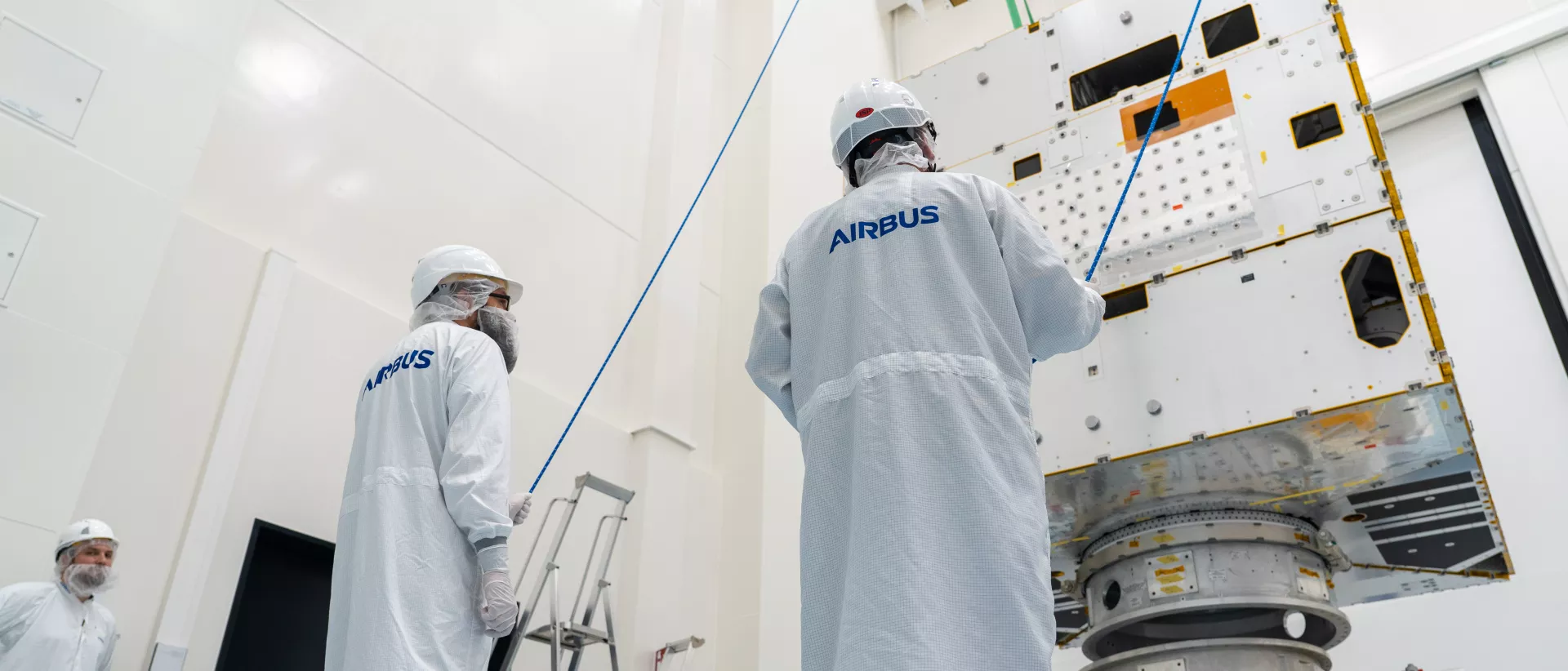
29.04.2024
Beyond Gravity: Key Products for new European navigation satellites
Over the weekend, two more European Galileo navigation satellites were launched into space. In parallel, work on the second generation of Galileo satellites is already underway on Earth. Beyond Gravity (formerly RUAG Space) delivers key products like thermal insulation, the mechanisms for solar array wings and thruster pointing, the satellite structure and the thermal insulation to the next generation of European navigation satellites.
On Sunday morning, 28 April, (European time), two further satellites were launched from a spaceport in Florida (USA), bringing the total number of Europe’s Galileo navigation satellites in orbit to 30. In parallel, work is underway on the next generation of Galileo. The first of a further 12 Galileo Second Generation satellites are due to be launched from 2025 onwards. Six of these satellites are being produced by the satellite manufacturer Airbus (Germany), while the other six are being built by Thales Alenia Space (Italy). “Galileo is currently the world’s most precise satellite-based navigation system. Beyond Gravity plays a key role in this project, supplying key products to both satellite builders of the second generation of navigation satellites”, says Oliver Grassmann, Executive Vice President Satellites at Beyond Gravity.
Backbone and thermal protection
For all six satellites built by Airbus, Beyond Gravity, a leading space supplier based in Zurich, Switzerland, will supply the structure (“backbone”) and thermal insulation. The structure is being built in Zurich and serves as the chassis of the satellite. The thermal insulation is being built in Austria and will protect the navigation satellites from the plus/minus 200 degrees Celsius temperatures in space and keep them at a constant room temperature. Beyond Gravity also supplies to Airbus the solar array drive mechanisms, which point the solar arrays of the Galileo satellites in the right direction to ensure that the satellite and its payload, especially the atomic clocks, have the right amount of electric power they are requesting.
12 pointing mechanisms for electric propulsion
For the six navigation satellites built by Thales Alenia Space, Beyond Gravity’s site in Austria is supplying a total of twelve mechanisms for gimballing the electric thrusters. The electric power thrusters are needed to bring the satellites to their desired Medium Earth Orbit (MEO) altitude and orbit after the Launcher releases them at 6000 km nominal altitude.
Electronics for antenna mechanisms
For the six Galileo satellites from Thales, Beyond Gravity’s site in Vienna, Austria, produces control electronics for the antenna mechanisms that establish direct communication between the Galileo satellites.
Launch adapter
At the Beyond Gravity site in Linköping, Sweden, the company designs and produces the launch adapter, which connects the Galileo satellites to the launch vehicle. Along with the according release mechanism from Beyond Gravity the adapter places the Galileo satellites into space.
About Galileo
Galileo is Europe’s civil global satellite navigation constellation, currently the world’s most precise satnav system, offering metre-scale accuracy to more than 4 billion smartphone users around the globe. With improved accuracy, the Second generation of Galileo satellites should be able to offer decimetre-scale precision positioning. The 12 Galileo Second Generation satellites will join the 30 first generation Galileo satellites in orbit today.
Six facts about Galileo from the European Space Agency: https://www.esa.int/Applications/Satellite_navigation/Galileo/Six_mind-blowing_facts_about_Galileo
Images of Galileo Second Generation
Image 1: Galileo Second Generation. Copyright: ESA.
Image 2: In November the structure for Galileo Second Generation, produced at the Beyond Gravity site in Zurich, was delivered to Airbus in Friedrichshafen. Copyright: Airbus Defence and Space
Image 3: The structure for Galileo Second Generation from Beyond Gravity at the Airbus cleanroom in Friedrichshafen in December 2023. Copyright: Airbus Defence and Space
Press release from Airbus on Galileo Second Generation and further images: https://www.airbus.com/en/newsroom/press-releases/2023-12-airbus-starts-galileo-second-generation-satellite-production
Image and video material of recent Galileo launch (First Generation)
Image of the current rocket launch of two Galileo satellites:
https://i0.wp.com/spacenews.com/wp-content/uploads/2024/04/f9-galileo1.jpg?w=2000&ssl=1
Video of the latest rocket launch: https://www.spacex.com/launches/mission/?missionId=galileol12
More information about the latest rocket launch of two Galileo satellites: https://www.euspa.europa.eu/newsroom-events/news/euspa-takes-over-galileo-satellites-leop
More information on Beyond Gravity products for the recently launched two Galileo satellites: https://www.beyondgravity.com/en/story/brain-and-coat-galileo-navigation-satellites
---
The Galileo program is managed and funded by the European Union. The European Commission and ESA have signed an agreement by which ESA acts as design authority and system development prime on behalf of the Commission. The views expressed in this Press Release can in no way be taken to reflect the opinion of the European Union and/or ESA.

